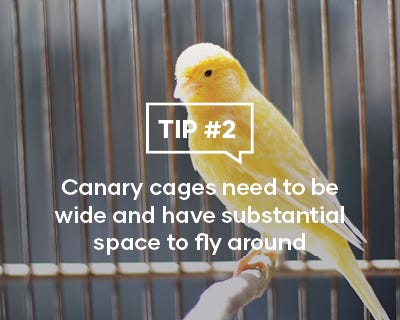Canary care guide
Canaries are well known for their pretty song with the male of the species being the best performers. They do well kept single, in pairs (male and female or female and female), or kept in large communal groups. Like all pets they require daily attention.
There are a variety of canary types available, resting into three main collections of birds known as 'Song birds' - those bred for their distinct song or singing ability, 'Colour birds', bred for unique colour variations and 'Type birds' - those bred for feature, form or type such as Crested canaries.
Canaries are hard to sex as they do not display visual differences between the sexes.
 Feeding
Feeding
High quality canary seed or pelleted diet should make up about 70% of your canaries' intake. The remainder should consist of fresh vegetables, greens and a small amount of fruits. Canaries love to rummage and pick through fresh greens.
Offer vegetables, leafy greens, or sprouted seeds every day. With some trial-and-error you will find your bird's personal favourites. Fresh greens are an essential part of your bird’s diet. Remove any vegetables or greens not eaten within 24 hours. It pays to limit the amount of millet sprays in their diet as these can become a fast favourite where your canary may pick these out (and leave the rest). Food and water containers should be emptied and cleaned daily.
If you wish to change your bird’s diet at any stage make sure that you do this over the course of a few weeks. Sudden dietary changes can cause digestive problems, so keep an eye on your bird's weight, stools and general well-being during this time. Water needs to be fresh, always available and changed daily. Like us, canaries appreciate quality and variety in their food. Once a week it's a good idea to offer your canary an additional protein supplement such as egg and biscuit mix or cooked egg.
Canaries don't require grit as they hull their seeds, but you can provide a cuttlebone that helps provide calcium and aids in digestion.
The following is a collection of fruit, vegetables and other food that we recommend:
Fresh food should always be thoroughly rinsed first.
|
|
DO NOT FEED lettuce, avocado, rhubarb, chocolate, alcohol, fruit seeds or caffeine as these can make your bird very ill. If in doubt, don’t feed it!
Treats
Offering treats can help to alleviate boredom and are a great bonding and enrichment tool. Treats should consist of no more than 10% of your bird's daily diet. Treats may include fruits and vegetables, seed bells, honey sticks, millet spray or treat nuggets. Feeding treats is a great way to help your canary bond with you and encourages positive experiences through rewarding food behaviour. Scattering treats can encourage natural foraging behaviours.
Behaviour, exercise and taming
Canaries are a naturally calm bird, they have sweet personalities and as a delicate flat bill they are unlikely to bite or be aggressive. However most canaries are uncomfortable with handling and are very much 'bird oriented' rather than 'people oriented' so are unlikely to become hand tame birds.
Canaries can be happy as a solitary bird, provided they have an enriching and entertaining cage set up. If keeping pairs it is best to have a male/female pair, or a large group of canaries. They can be housed with other flatbills such as finches but are not recommended to be housed with larger species or hookbills (budgies, cockatiels, parrots etc). When keeping with finches it is important that there are separate feeding and nesting areas to minimize territorial behaviours.
They are not a destructive bird and do well with a variety of nesting or foraging toys, but are not the type of bird to 'rough and tumble' or play in the same way as larger species or parrots.
Moulting
Moulting can be an uncomfortable and often stressful time for your bird. You may see plastic looking 'pin feathers' where there is a sheath over the new feather. Sometimes these can get quite irritating for your bird and you will see them rubbing their head to help loosen the new feather. Old feathers around the tails and wings may drop at this time, leaving your bird looking quite 'straggly'. Offering tepid sprays with water, and a bath, may help to encourage grooming behaviour. You can also offer a vitamin supplement and additional protein (e.g. conditioning food) to help your bird through this period. Young birds will often have their first moult around 6-12 months of age, and then with each change of season.
This process takes between four to eight weeks and during this time your bird will be more susceptible to changes of temperature so make sure that its environmental temperature is stable. Your bird will need more protein during this time and this can be delivered by a soft egg-based supplement or conditioning food.
A vitamin supplement during this phase is also recommended. Growing new feathers takes a lot out of a canary.
Grooming and health
Encouraging bathing helps waterproof the feathers, further encouraging grooming and general feather health. Not all birds will naturally bathe in a bird bath or bowl however you can teach them from a younger age. Over the warmer months, baths should be offered daily. Alternatively many birds will appreciate a light misting using fresh water in a spray bottle. This can embolden your canary to display bathing behaviours and gain confidence near their bird bath.
Always ensure baths/sprays are given on warmer dry days, and your bird is able to fully groom and dry off so they don't catch a chill. Bathing/spritzing is especially helpful over moulting periods to help promote new feather growth, and loosen any dry pin feathers.
Nails should be trimmed by a qualified professional. You should worm your indoor bird every six months or every three months for your outdoor aviary birds.
The signs of a healthy canary are:
- Active, alert and sociable
- Dry nostrils and bright eyes
- Beak, legs and feet should look normal
- Eats and drinks regularly
- Has smooth, well-groomed feathers
The signs of an unhealthy canary are:
- Sitting on the floor of the cage or low on the perch
- Wheezing or coughing
- Eye or nasal discharge
- Fluffed, plucked or dirty feathers
- Diarrhoea or discoloured stools
- Red or swollen eyes
- Favouring one foot
- White scales around the eyes, beak, legs or feet
- Appetite loss
- Holding wings low and drooped

Housing
It is best to provide the largest habitat that you can afford. The ideal size for one canary is 60cm (W) x 45cm (D) x 45cm (H). Bigger cages are always better and have more room for your pet to exhibit natural behaviours. Canaries enjoy wide open spaces and are flyers rather than climbers so the width of the cage is the most important aspect. Stay away from rounded cages and be mindful of bar width to ensure your bird cannot escape.
Perches need to be a variety of textures, widths and lengths. This variety will exercise your bird’s feet and aid in the prevention of arthritis. It also more closely simulates life in the outdoors.
A metal grate over the bottom of the cage may help to keep your bird away from its droppings, although it can be a better idea to remove these if the cage style permits for natural foraging behaviours. Many birds like to pick through their floor, play and explore and this is much more fun without the bars.
Cage placement
Keep your bird in the part of the house that is social so your bird can be an active member of the family. Keep it out of drafts and off the floor.
Cover your bird’s cage at night to prevent “night fright”. Canaries need about 12 hours of rest a night. This also helps your pet get used to a regular routine, and you may find your bird starts to recognize their evening routine.
Cage tips
- Don’t place food or water containers underneath the perches – this will prevent possible contamination.
- Avoid cooking near your bird with non-stick cookware as these can release harmful fumes.
- Clean the cage and perches regularly.
- Replace food and water daily.
- Remove uneaten vegetables after 24 hours.
- Replace perches, dishes and toys once worn or damaged.
- Rotate toys regularly.
- Add in bird safe branches to encourage foraging and play.
- Make sure there are no parts or toys in your bird’s cage that are lead, lead-base painted, zinc or galvanised metal.
- Remove any seed husks that collect on top of the food bowls.
Recommended supplies:
|
|
Is a canary right for you and your family?
- I have the appropriate location and housing for this pet.
- I will provide a safe and enriching environment for this pet.
- I realize that owning this bird will be a long term commitment (up to 15 years).
- I understand that this pet does not require handling or time outside a cage although does require a flight area in its cage.
- I can financially provide for all care requirements and any veterinary attention needed.
- I am aware that birds can be vocal and this is acceptable for my family and my neighbours.
- An adult can provide primary care for this pet.
Average size: 7.5cm to 10cm
Life span: 10 - 15 years



